Tillandsia zacapanensis
Click thumbnails for full size, scaled to a new window.
Tillandsia zacapanensis
Species, Guatemala
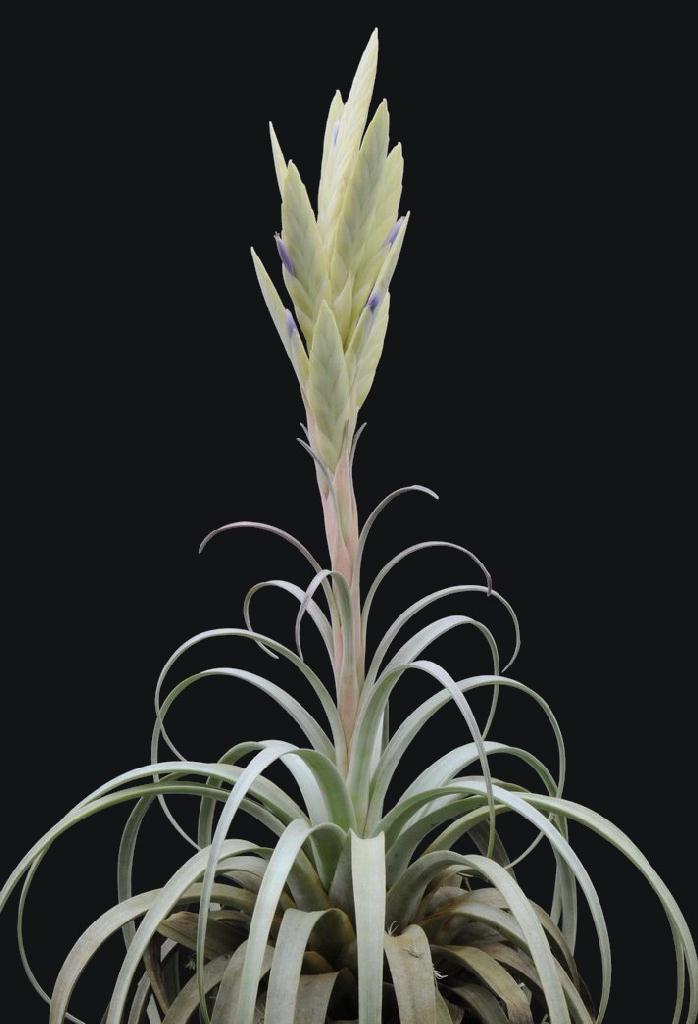
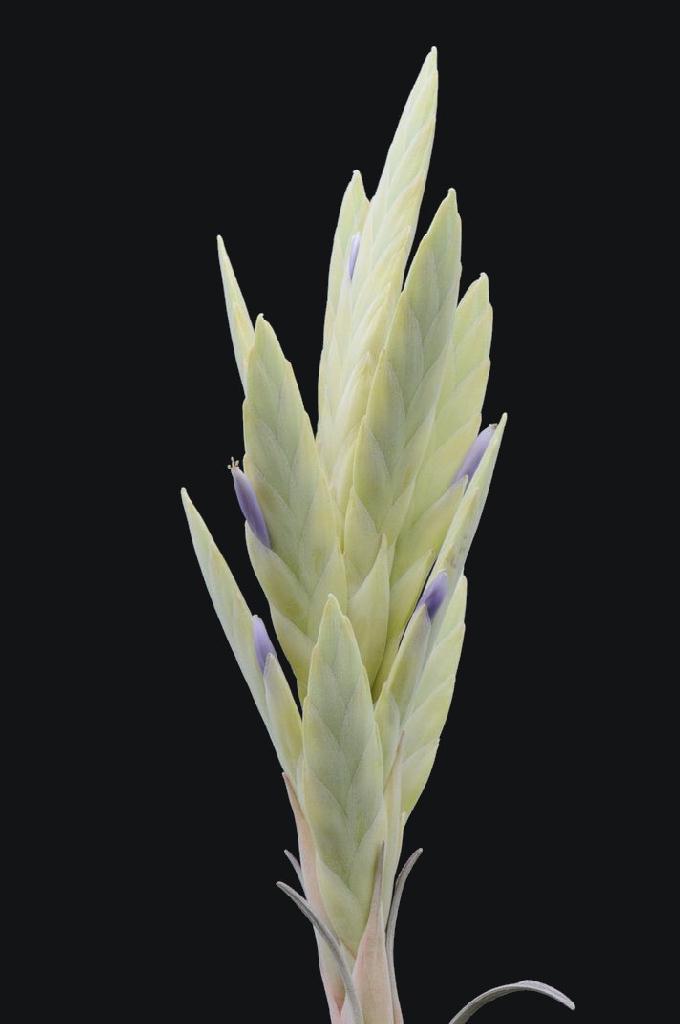
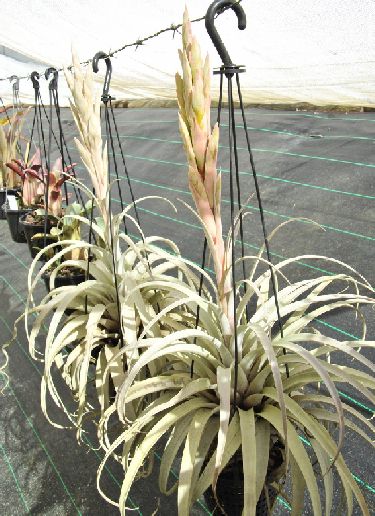
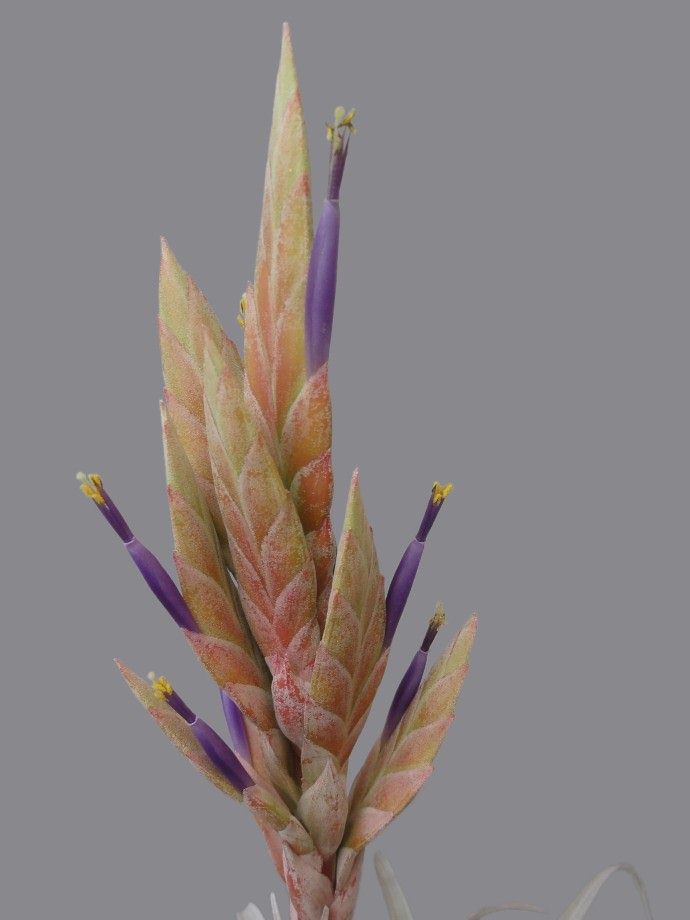
| Peter Tristram 02/11. |
Peter Tristram 05/13. 2 clones. |
Stephen Haines 03/15 |
From Peter Tristram 09/02/11 - "Those who get Die Bromelie will have seen the article on this new species from Guatemala in the recent issue. As it turns out, I got what appears to be it from Doetterer’s in 2006 indirectly via Renate Ehlers as an unknown hybrid. When I was in Germany in 2009, a few people were discussing a Doetterer plant with a tall pink and white spike that seemed to fit my plant foliage-wise. They were discussing parentage! When it began to bloom recently and having helped with the article, it started to dawn on me that this plant could be T. zacapanensis. I emailed Renate who confirmed the batch Doetterer had a few years back were T. zacapanensis. The ones in the article are much pinker on the whole though and I don’t think this is conditions as the Germans have also flowered theirs with white branches. The plant has been compared with T. carlsoniae (a contentious translation though so that will be reprinted). In my experience it’s seems a fairly dry and slow grower, liking warmth too. I hope it pups!"
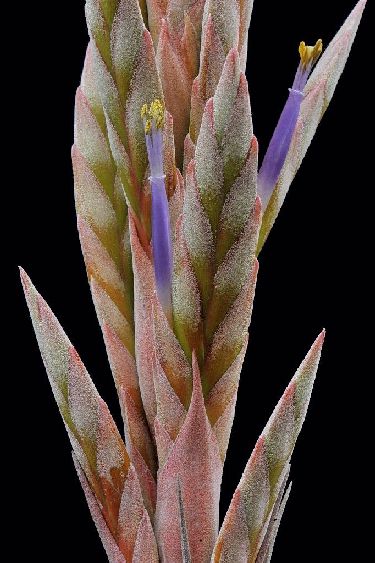
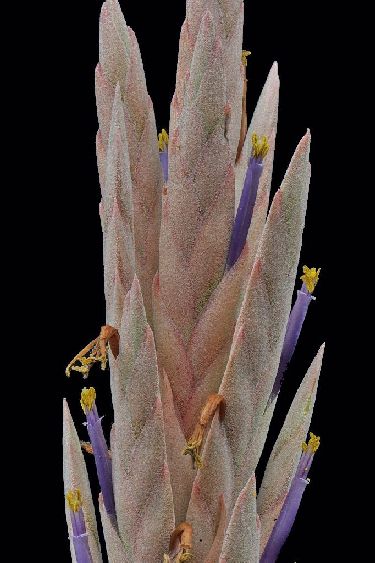
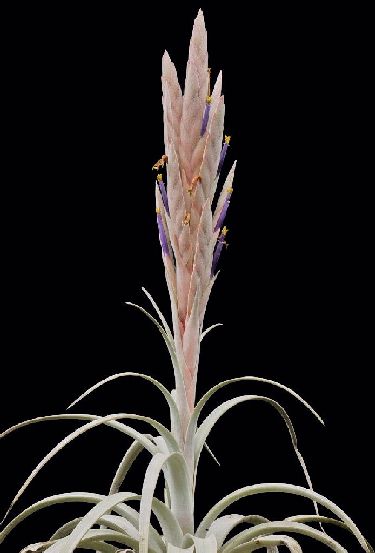
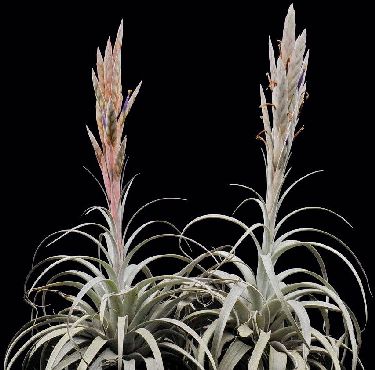 Peter Tristram...."Chris was lamenting that his zacapanensis needed a suntan. Mine are finally pushing out flowers. Being mid-winter I expect the colour will deepen as the light intensifies but they look pretty damned good as it is. You can see that the wet weather this year did some damage to the foliage (the ones under cover are fine, but not in bloom) so I would recommend a drier location, like with xerographica, for this species. At least I am sure they are 2 distinct clones so maybe I can set pure zacapanensis seed."
Peter Tristram...."Chris was lamenting that his zacapanensis needed a suntan. Mine are finally pushing out flowers. Being mid-winter I expect the colour will deepen as the light intensifies but they look pretty damned good as it is. You can see that the wet weather this year did some damage to the foliage (the ones under cover are fine, but not in bloom) so I would recommend a drier location, like with xerographica, for this species. At least I am sure they are 2 distinct clones so maybe I can set pure zacapanensis seed."
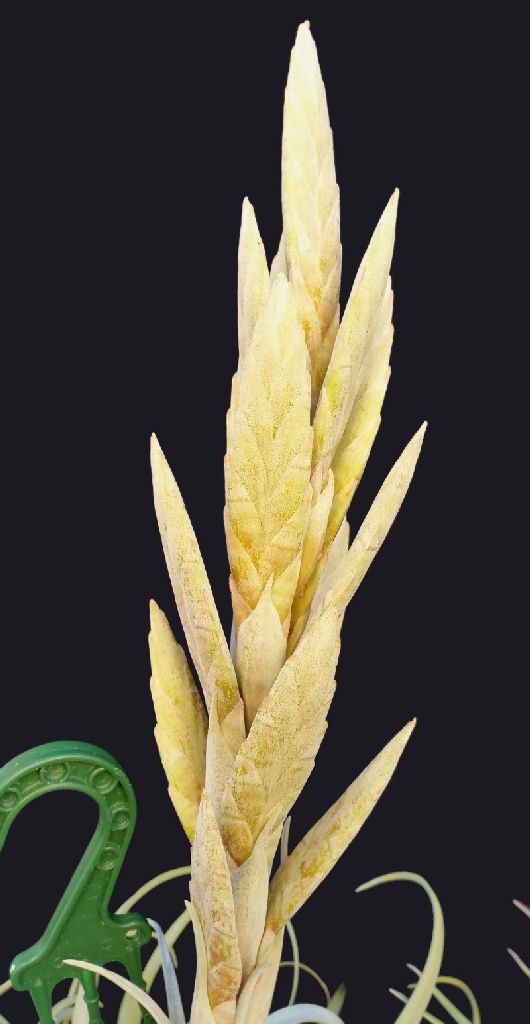
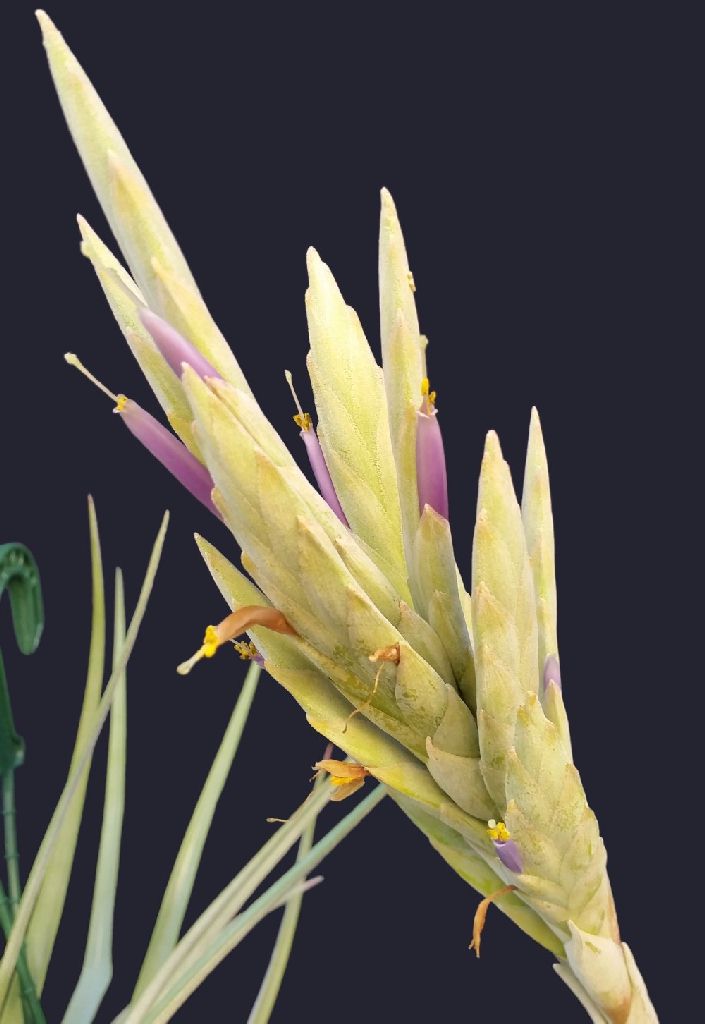
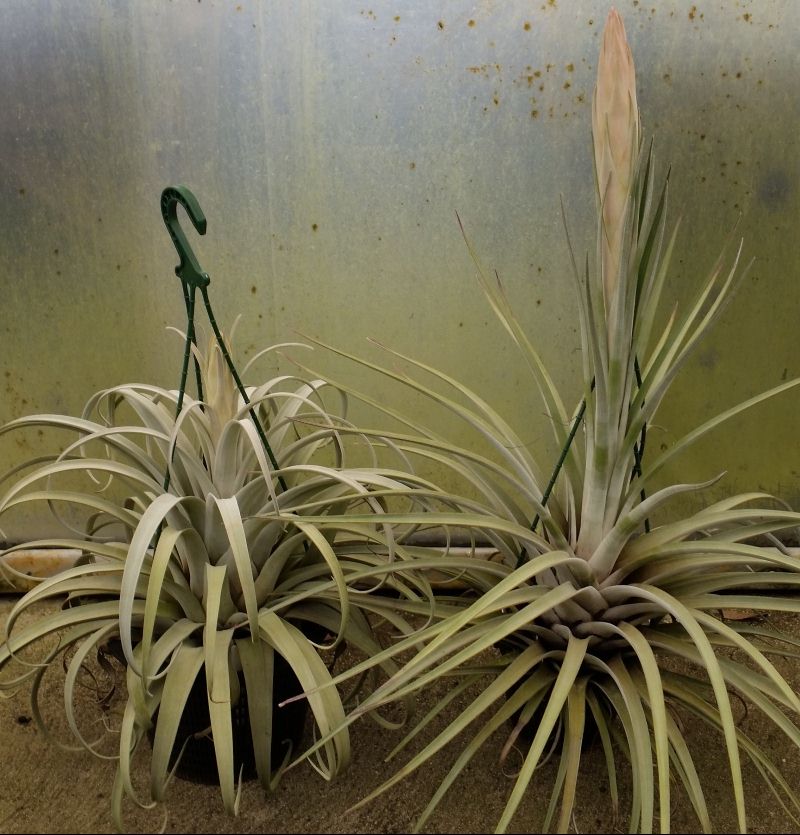
| Chris Larson 03/16* |
Chris Larson 03/16 carrilloi on left |
Derek Butcher ... "Chris: Both Renate and Eric consider zacapanensis and carrilloi synonymous.
Now for history. In 2010 we first saw zacapanensis published by the Guatemalans but in 2011 we saw this amended by Lotte and Renate. In 2013 we saw carrilloi published by the Guatemalans in an obscure journal (Could it be they did not want the Germans fiddling with it?) As as an aside Veliz was involved with both descriptions and he was the one who wrote the Guide to Guatemalan Tillandsias. You will find this in the DVD marked suspect because I feel it is full of anomalies.
In 2014 I received photos from my Thai friends of carrilloi which they had got from Guatemala and which did not fit the description of either carrilloi/zacapanensis. I smelt something fishy.
So all I can suggest is that when your carrilloi flowers you check it against the descriptions and then decide if the name is right."
Chris Larson* ... "The first 2 photos are different T. zacapanensis in flower, or nearly. The one that has flowers (centre) has flowered a little small & has been in a darker position. The other (left) is beginning to colour.
The comparative shots were a bit blurry. I'll redo the photos later and post them then.
These are the larger carrilloi (left) and the smaller zacapanensis (right) shown flowering now.
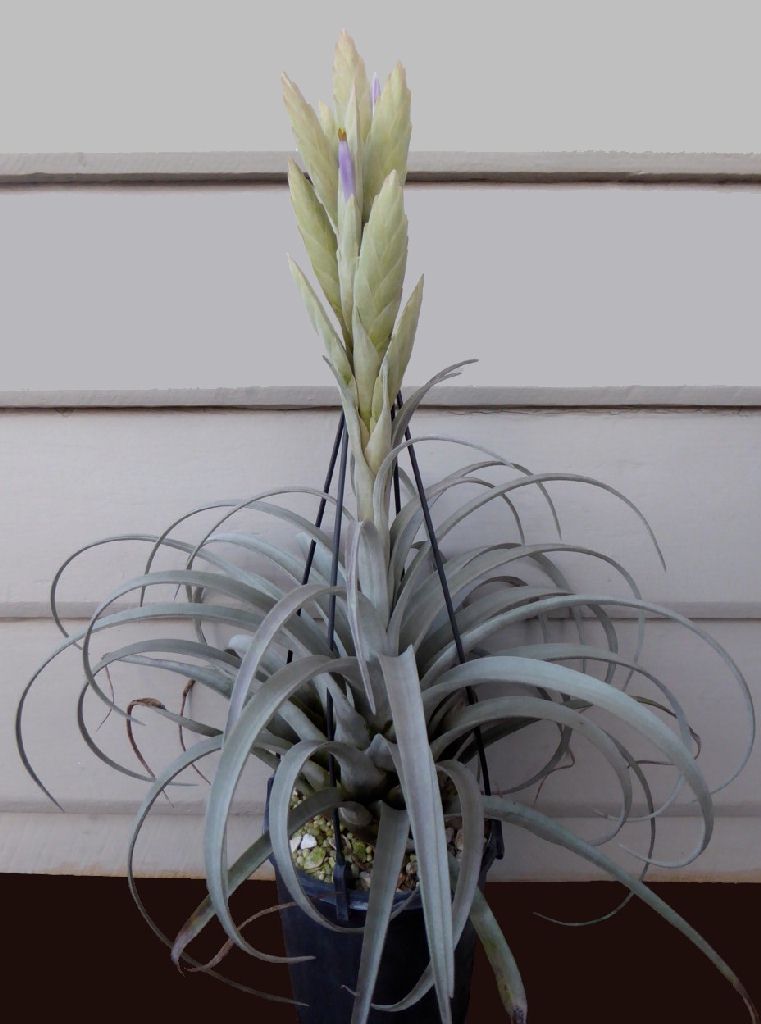
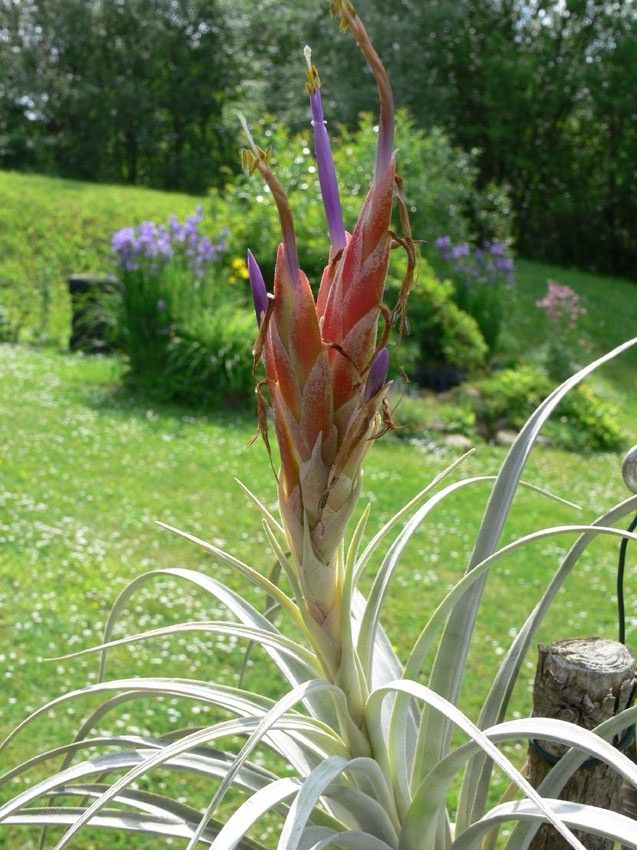
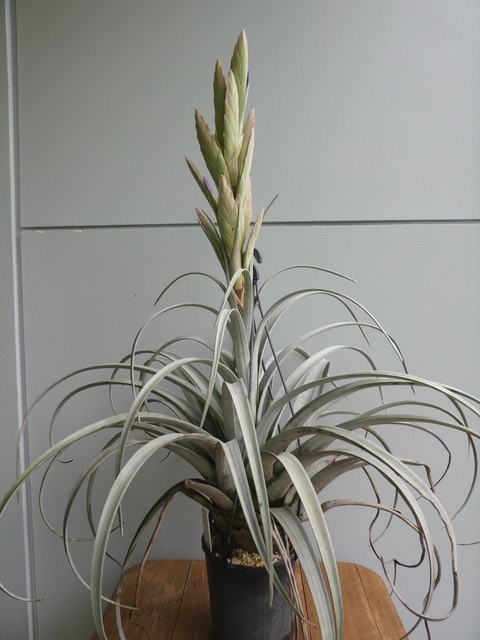
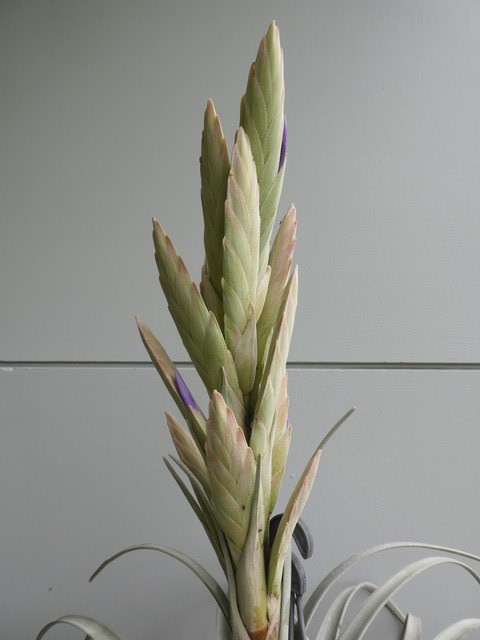
| Bruce Dunstan 02/17 |
Andreas Böker. See notes below. |
Bruce Dunstan 02/21 |
Derek Butcher ... "Bruce: Interesting, you clearly got your plant from the same source as Peter Tristram.
It is one where the Germans did not see eye to eye with the Guatemalans. See notes below."
Bruce Dunstan ... "I also have a grey clone from Peter to play with. It has less of the white trichomes on the foliage. I'll post an image when it does it's thing."
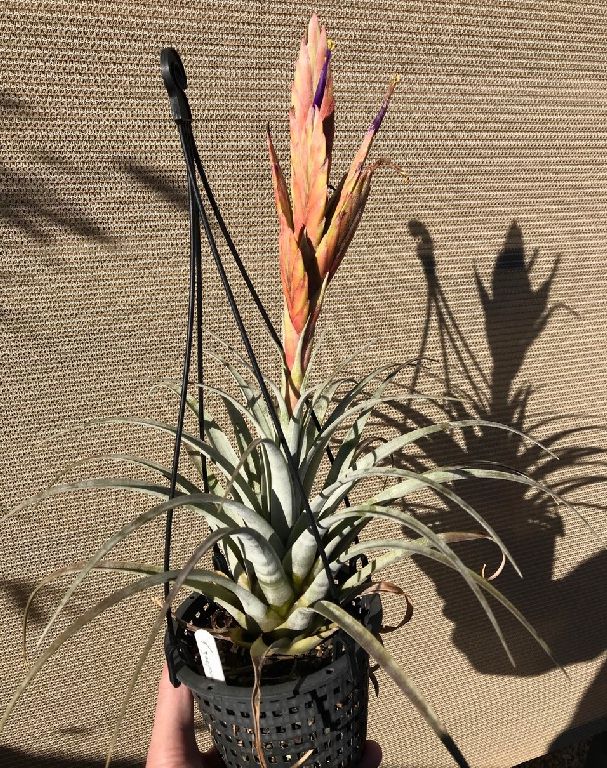
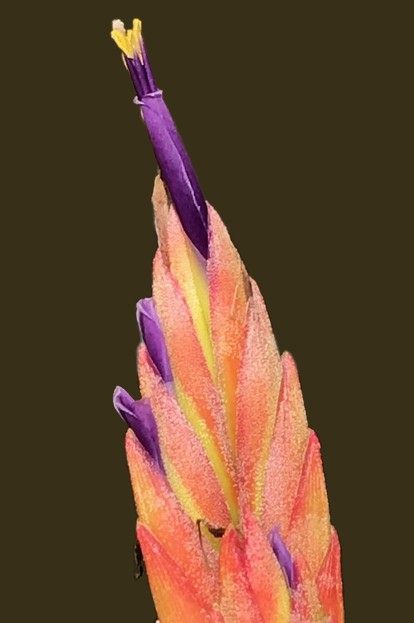
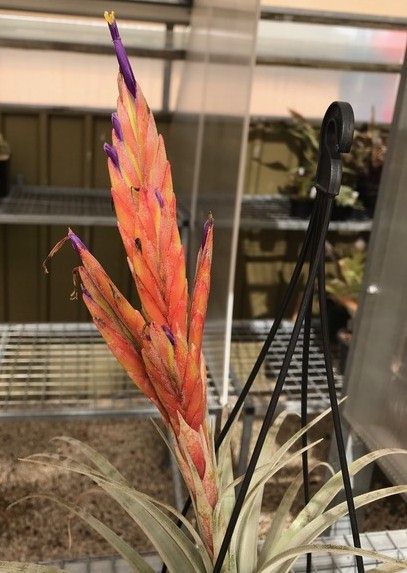
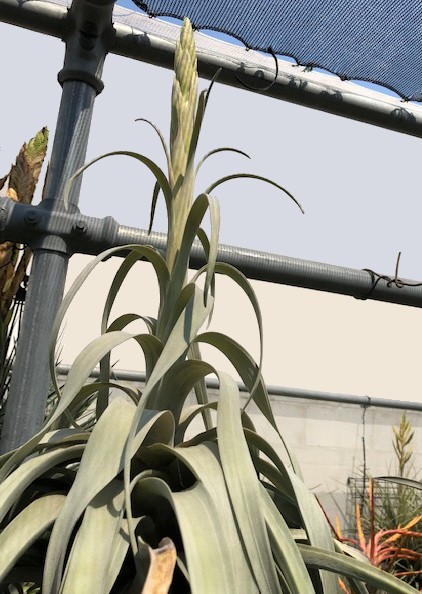
| Ray Clark 06/19 |
Ray Clark 07/19 |
John Olsen 12/19 Guatemalan form* |
*Chris Larson ... "Hi John. I saw your comment 'Tag says Guatemalan form'. Unless this is one of your imports I'd say it comes from one of my tags as "ex-Guatemala". Denoting the import was from Jeronimo in Guat. All T. zacapanensis come from a small region in Guatemala."
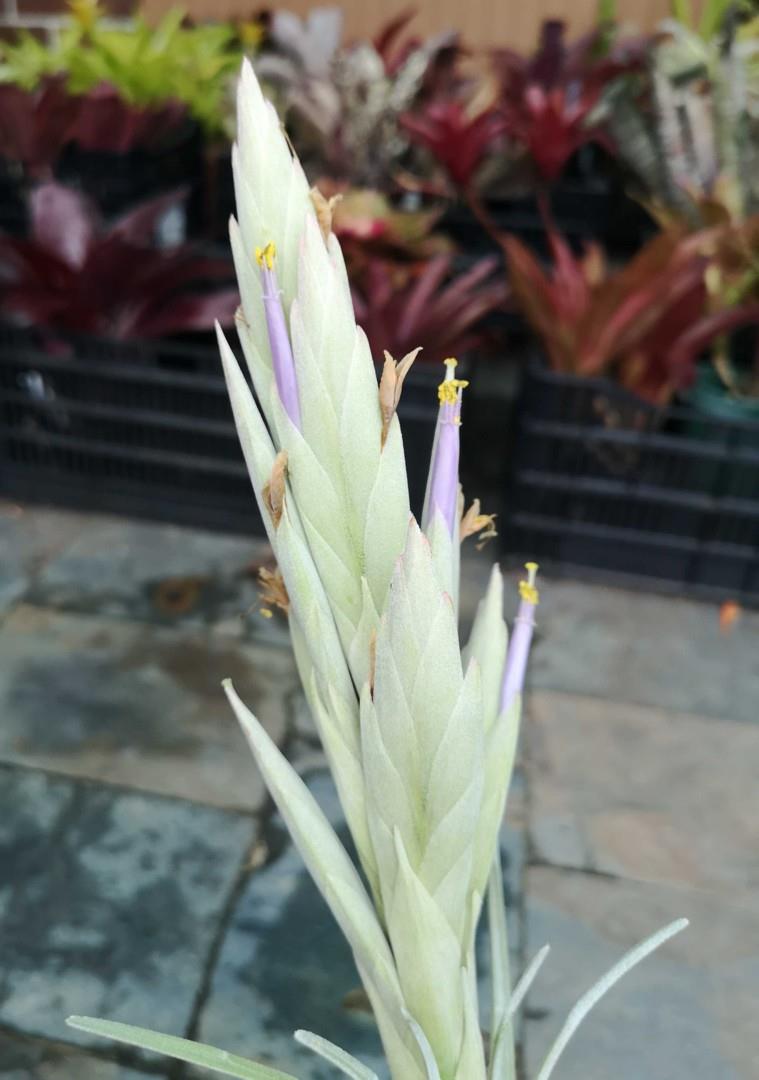
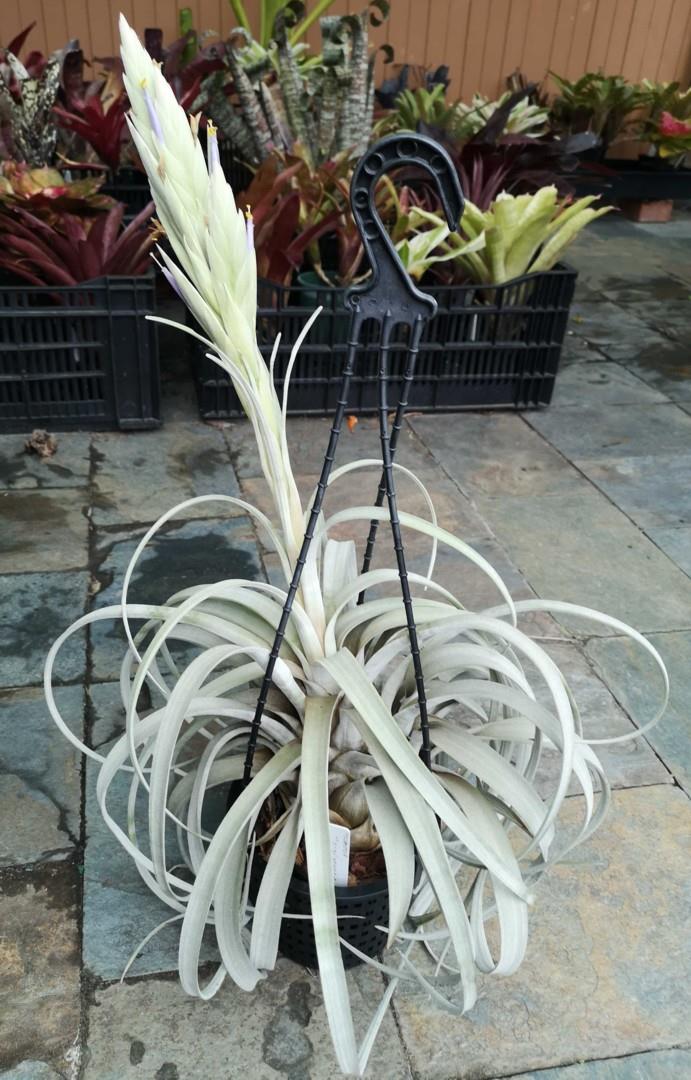
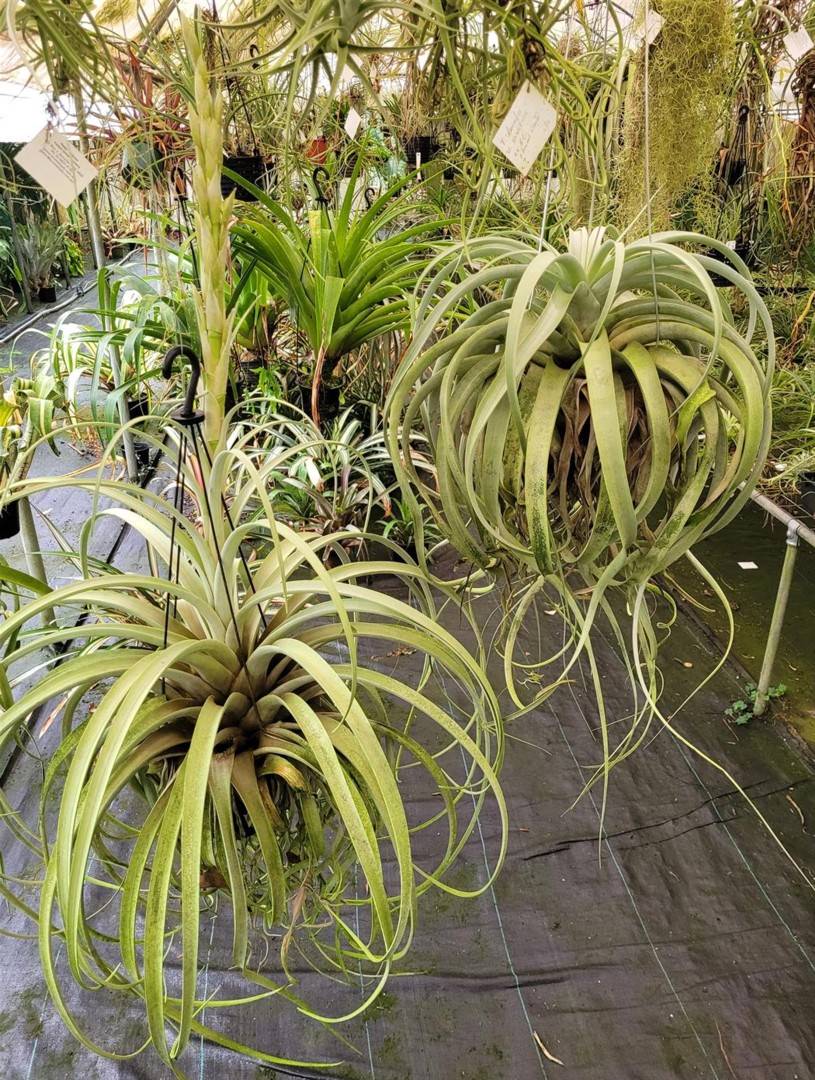
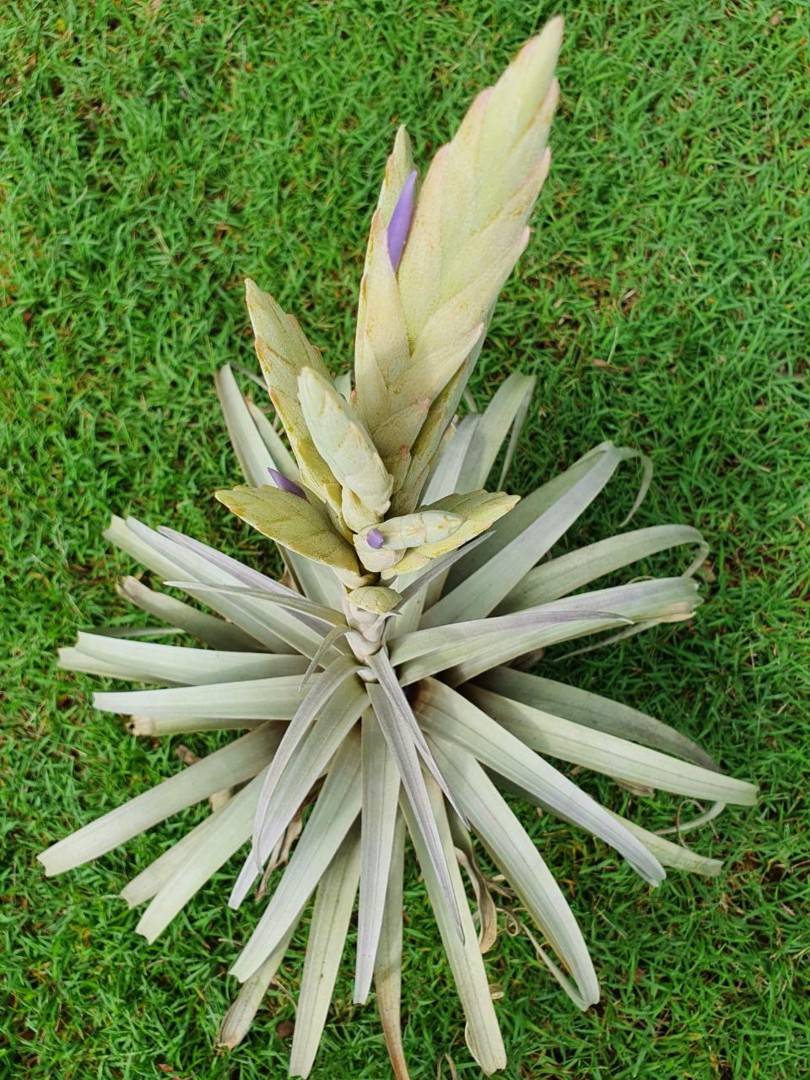
| Harold Kuan 08/21 |
Peter Tristram 01/22 |
Pam Butler 02/22 |
Harold Kuan ... "My first time flowering this big beauty. Probably would like some more light, but it gets what it gets!"
Peter Tristram (08/21) ... "Harold: Well grown! It’s a plant I first saw in Germany over 10 years ago, ex Feldhoff in Guatemala, unnamed of course. The first one, a greyer version, was given to me by Renate Ehlers, thought to possibly be a xerographica hybrid. At the same time Feldhoff sent some zacapanensis, as carrilloi, but it was a couple of years before I could get any.
There are great articles in Die Bromelie about these 2 amazing, easy to grow species. There’s also an article in the latest BSI journal, by Graeme Barclay, on T. zacapanensis, with lots of info and pics. The species can become very large too, if it doesn’t bloom for many years. I have some giants, all white-leafed forms.
There are many clones in cultivation now too and a bunch of hybrids are on the way. With Andrew Flower as the BSI Journal editor, lots of great species articles are being published, especially by Eric Gouda. Michael Barfuss, who’ll be a keynote speaker at the next Australasian conference across the Ditch, is now the editor of Die Bromelie. Both are journals any avid Till grower should subscribe to!!"
Peter Tristram (01/22) ... "Recently Bruce Dunstan posted a pic of a lovely T. zacapanensis on facebook. Unusually I can boast a larger plant!! I have had a few, imported around 10 years ago, that hadn't bloomed, just getting larger and larger. Finally 2 are blooming so I took a shot of one next to a very large Guatemalan xerographica for comparison. It’s been grown in a reasonably bright tunnel house and fertilised regularly with Peter’s Professional and CalMag (at a lower rate than Bruce uses though, around 1000 ppm TDS). Interesting how species can vary! The leaves are nearly 1 m long, the spike 80 cm."
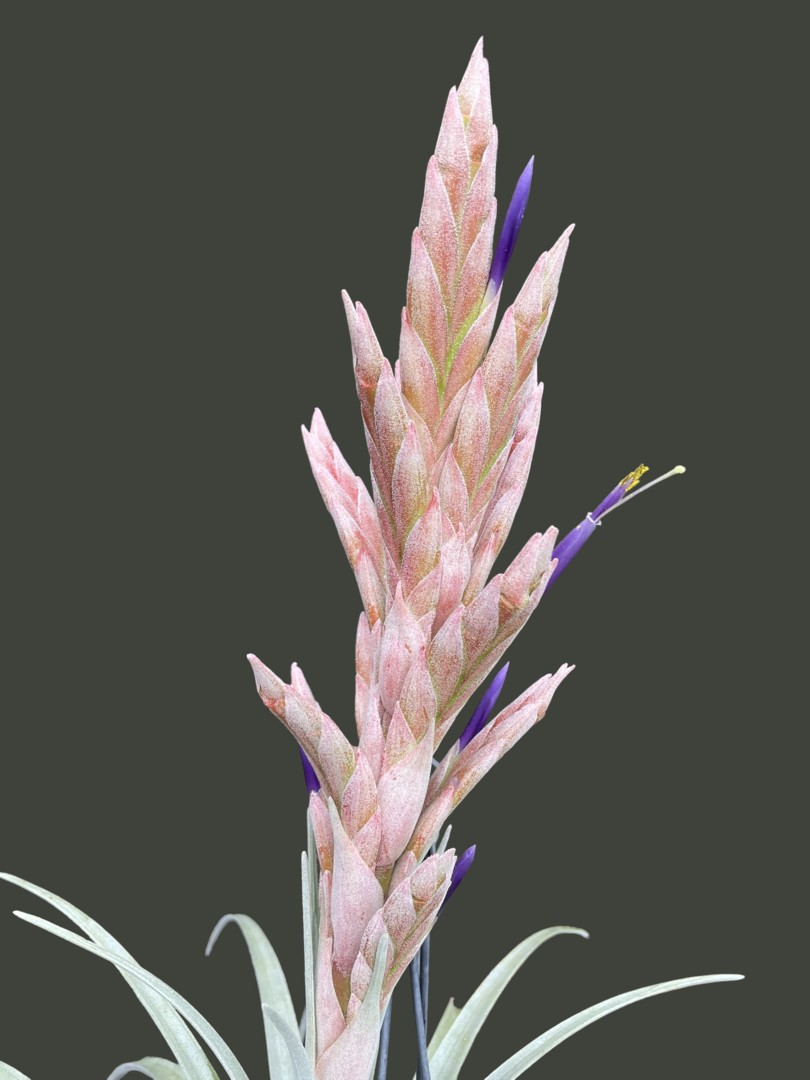
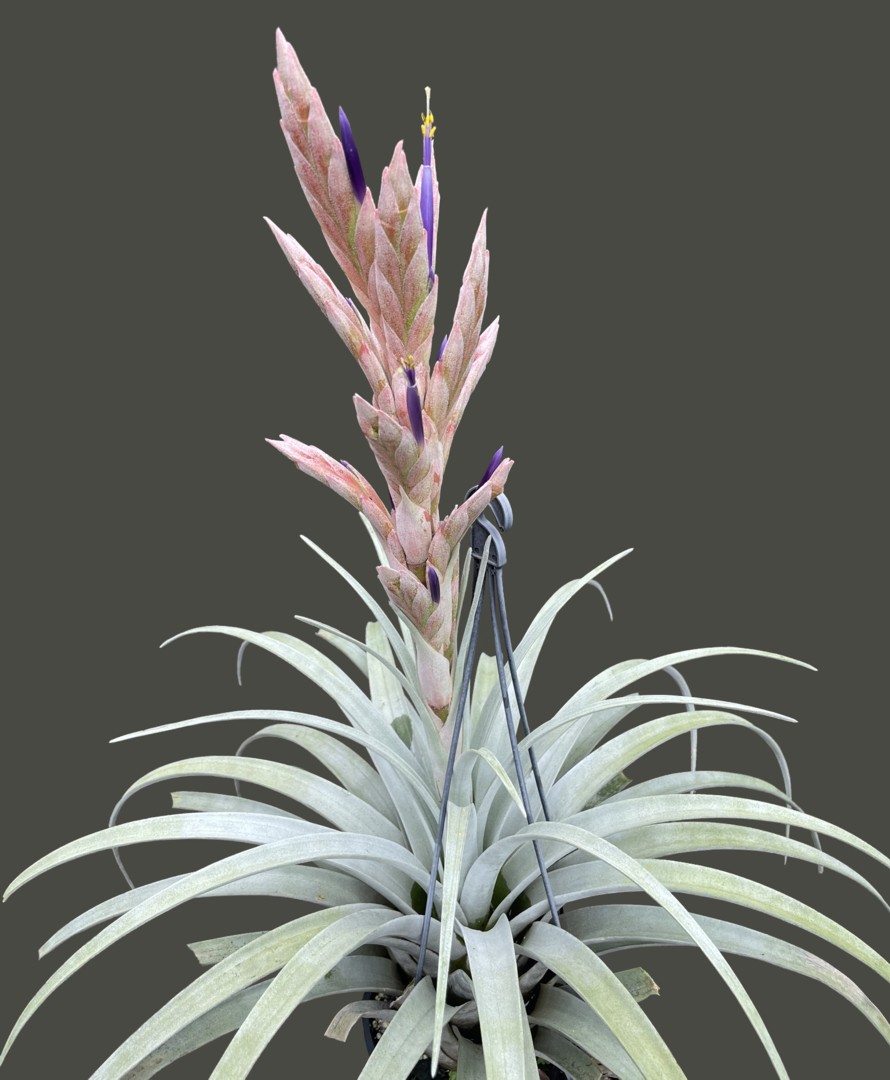
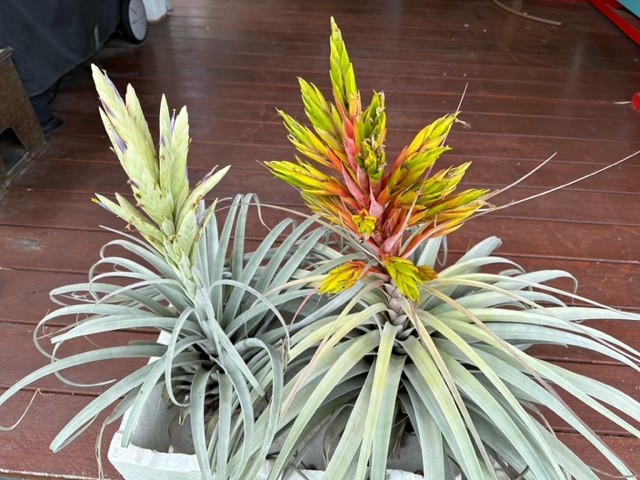
| Bruce Dunstan 09/22 |
John Olsen 02/23* |
*John Olsen ... "I took along these two, both labelled zacapanensis, to our Tillandsia group. The colourful one came from Chris Larson and the ordinary looking one from Lotte.H. via Peter Tristram and BD labelled zacapanensis white."
Ray Clark ... "Hi John, your two separate pics of T. zacapanensis piqued my interest. Looking on BinA I see pics for what appear to be variations on the them that fit both of your plants. I was hoping to understand more about which might be true to description but got lost in the tale of how Renate and Lotte spent a day scrambling over rocks somewhere out of Zacapa!"
Alfonso Trudu ... "I think they both look great and very interesting. Could they be considered for reclassification as long as some field data are available? Maybe Eric can help us out."
Peter Tristram ... "I'd have liked to have had a closer look at that red one! I don't think it fits the description at all from a cursory look. Might have been a ring-in from Jeronimo! More like a xero hyb."
Chris Larson ... "Hi all - The zacapanensis / carrilloi story. - All a tangled web.
From a distance the way I heard it - through Chinese whispers: All about certain Guatemalan nurseryman reportedly stripping the habitat. Long associations broken between European collectors and said nurseryman because of it.
Then, as I understood it, Jeronimo bought material from said nurseryman and onsold it to people like me.
We go back to that time: Uncle Derek would not believe me that there were 2 plants carrilloi & zacapanensis because the Europeans were refusing to recognise that they were different species - and they were saying they were all zacapanensis. My memory says it was because the Europeans couldn't visit the carrilloi site because all the plants were gone. Was it because they were cheesed off with said nurseryman stripping the sites?
Derek was very difficult to persuade that there were 2 different species - because he was following the European opinions. It was only when I provided him with photos of T. carrilloi all the way through - where the bracts curved outward in the latter stages, that he finally came around - it was consistent with the descriptions. So Derek's writings on these 2 sp were a little off IMHO.
Now all of this is 3rd hand or 4th or 5th. So who knows the accuracy.
All the while we got some imports directly from Europe, and some from Jeronimo in Guatemala. It was hard to know what was what until we had flowered all of the material and sorted out the concept of what the species actually were. (Reminds me of the situation with T. kretzii.)
This particular plant as far as I could tell was a plant Jeronimo threw into the shipment with T. zacapanensis on it. There was also one very similar to George's T. Super Betty in there. Even when they were flowering no-one could give us a good idea what we were looking at - until we started to understand.
In hindsight, I'm with Peter - something from Feldhoffs nursery - via Jeronimo - misnamed as T. zacapanensis with a xero look to it.
I haven't flowered the plant I have which is in that group and may be similar for quite a number of years. I'm not even sure if I have this one left."
Tillandsia zacapanensis Veliz & U. Feldhoff, Die Brom 3: 126-130. 2010. See Die Brom 2: 80-81. 2011 for amendments shown in a table.
A Tillandsia carlsoniae L.B. Sm., cui affinis, pedunculo longiori, inflorescentia divisa lepidota, spicis 12-19 cm longis et sepalis 3-4 cm longis differt.
Typus: Guatemala, Departamento Zacapa. in rupibus una cum Stenocereus pruinosus (Otto) Buxb., Opuntia guatemalensis Britton & Rose et Pilosocereus leucocephalus (Poselg.) Byles & G.D. Rowley, 600-900 m s. m., 15. Junio 2005 (florens), U. Feldhoff 001 (holo BIGU, iso MEXU).
Paratypus: Guatamala, Municipio San Juan Sacatepequez, 29 Dec 2006, M. Veliz, U. Feldhoff, J.A. Veliz & R. Veliz MV18317 (BIGU 38001).
Plant lithophytic, flowering up to 55 cm high, stemless.
Leaves 25-35 cm long;
sheaths 4-6.5 cm long, spotted, abaxially with a brown margin at the base;
blade above sheaths 2.5-4 cm wide, densely covered by grey scales, recurved, arching and pendent, narrowly triangular, acuminate.
Inflorescence erect;
Peduncle 14-20 cm long;
basal bracts triangular and acuminate, the middle ones inflated, the apical ones very narrow and inconspicuously inflated, elliptic, tube-like clasping the axis, densely covered by scales;
inflorescence (fertile part) dense, with side-branches of first order,
lateral branches ascending with an angle of 15°-17°;
primary bracts coriaceous, much shorter than the lateral branches, densely covered by scales, carinate, triangular;
spikes 10-14 cm long, ascending,7-14-flowered;
floral bracts 37-41 mm long, much shorter than the sepals, imbricate, appressed to the axis, carinate, coriaceous, lepidote.
Flower sessile,
sepals 35-40 mm long, succulent, glabrous to slightly covered with scales, slightly canaliculate, adaxial sepals carinate, connate for 12-20 mm, the free sepal ecarinate;
petals violet/mulberry-'coloured, 6-6.5 cm long, glabrous;
stamens exserted, 70-75 mm long, lilac; anthers 6 mm long, 1 mm wide;
ovary 7 mm high, glabrous, style 7 cm long, exserted, stigma with three lobes.
Fruit a three-loculicide capsule, 25-30 mm long, 5-8 mm in diam., each locule with 60-66 seeds.
Habitat: Tillandsia zacapanensis dwells on limestone rocks in dry spinescent forest in Guatemala. On the shallow clay soils it is found growing sympatric with Stenocereus pruinosus (Otto) Buxb., Nopalea guatemalensis Rose, Pilososcereus leucocephalus (Polgers) Byles & Rowley, Pereskia lychnidiflora DC., Guaiacum sanctum L., Ceiba aesculifolia (Kunth) Britton & Rose, and Mimosa zocapana Standley & Steyermark. Flowers appear from June until August.
Distribution: To date, it is known from the type locality in Zacapa only, 600-900 m elevation.
An unexpected discovery.
"I went, myself, along the mountains and aimed at finding all of them. Suddenly, I saw stone and rock, my heart begun to fly - maybe, up there the tillies thrive ..." an unfolding poem, openly after Heinz Erhard.
A Friday, in August 1999, 6.15 p.m., in Zacapa, Guatemala, in a hotel: Hector and I get up, have a shower and go for breakfast, as usual on our weekend enterprises. Eggs, scrambled or sunny side up, beans parado or volteado, tortilla, coffee or 'jugo de naranja', sometimes both. We planned to go from Zacapa, via the mountains, on the gravel road, to Santa Rosa and to the Puente Los Esclavos and enter all Tillandsias seen on our lists. That didn't come true, 'Gracias a deus'. After about 40 min driving, on the left hand side at about 800 m above sea level, we saw huge rock formations and it came to my mind what Rauh always said to me: "Uwe, keep an eye on the rocks! All the others search in the trees."
After 30 minutes of climbing we indeed reached them: the NEW Tillandsias, some with young inflorescences and others already flowering. The whole area was rather steep and hot with thorny vegetation, all in all a considerable torture, but it was worth it. There were hundreds of plants on a total area of about two soccer fields. We were blown away. By the time we calmed down it was already 4 p.m. and too late to follow our original plan. We were thirsty, hungry and 'made dust'. Back in Zacapa, we had started without water and food, since, on our way, we were planning to pass through several places where we could obtain these without any problem.
After returning to Zacapa we returned to the same hotel. The owner was astonished when we reported about our journey to Santa Rosa. After showering, drinking and eating we could again focus on the day that had been. We were fulfilled with joy and pride. Not every trip is that successful. Tomorrow we would restart with the plan that was actually thought for today.
Following Flora Mesoamericana (Davidse et al.1994: 100-256), the new species is probably related to Tillandsia carlsoniae, although the latter has a very short peduncle compared to this new species. Like T. carlsoniae, the new species possesses a branched inflorescence that is covered in scales with lateral branches of 12-19 cm length and sepals of 3-4 cm length (Smith & Downs 1977, Standley & Steyermark 1958). The new species is named after the Departamento de Zacapa in Guatemala, where it was found.
T. zacapanensis Diagnosis by Lotte Hromadnik & Renate Ehlers see Die Brom 2: 80-81. 2011
| . | T. carlsoniae | T. zacapanensis |
| Habit | epiphytic in forests 1500–2400m | lithophytic on lime-rocks 600–900m |
| Flowering plant | 25cm high | 55cm high |
| Leaf-sheaths | 70-120mm long | 40-65mm long |
| Peduncle | very short, hidden by the leaf-sheaths | 14-20cm long |
| Inflorescence | Capitate, with dense same length spikes, not exceeding the leaf-rosette | long-elliptical, with upright spikes, densely pressed to the axis, exceeding the leaf-rosette |
| Spikes | ca 8 flowered, 10-12 cm long, several sterile bracts at the base | 7-14 flowered, 10-14 cm long |
| Flowers | Short stemmed | Sessile |
| Floral bracts | To 50 mm long, exceeding the sepals, scaled, not keeled | 37-41 mm long , as long as sepals, scaled, keeled |
| Sepals | 40 mm long, densely scaled, the adaxial pair unkeeled | 35-40 mm long, glabrous or hardly scaled, the adaxial pair keeled |
| Petals | 6 cm long, dark purple L.B. Smith. Rauh: flowers blue: with Ehlers collections: upper part violet, lower half white | 6-6,5 cm long, violet /mulberry coloured, bottom part white |
Extra comments not published
Comparing T. zacapanensis with T. carlsoniae L.B. Smith
T. zacapanensis grows lithophytically on lime-rock in hot areas near 900 m s. m. not epiphytically in forests 1500–2400 m.
Plant flowering to 55 cm high not only 25 cm, leaf-sheaths shorter, peduncle to 20 cm long, not almost lacking.
Fertile part of inflorescence long-elliptic, to erect, with spikes densely appressed to the axis, exceeding the leaf-rosette, not with dense digitate spikes which do not tower over the leaf-rosette, spikes with more, sessile, not short pedicelled flowers; floral bracts shorter, about as long as the sepals, not exceeding them, clearly keeled instead of not keeled; sepals almost glabrous instead of strongly scaled, clearly adaxial pair keeled instead of not keeled.
Derek Butcher ... Questions about the description for the Lector:
In prehistory: At 800 m we climbed for 30 minutes. The location as far as known is only as big as 2 soccer fields. Why does this become 600 - 900 m declared as height of the type locality?
Why hanging leaves? On the photo, the leaf-sheaths are rather erect, the spreading blades somewhat bent over. But hanging?
Peduncle bracts: tubular enclosing the axis? The whole peduncle bracts enclose the axis, as a tube? Or the sheaths enclose the axis?
Inflorescence scaled: does this mean the peduncle bracts and the floral bracts of the spikes?
Spikes in diagnosis 12-19 cm long. In description 10-14 cm.
Floral bracts shorter than the sepals: the dimensions is almost the same. On picture e, one clearly sees on page 127 that the abaxial sepal is equally long and the adaxial pair show by reason of the other part of the ovary is about equally as long as the floral bract.
What is mulberry colour? Lotte says, those are often white!
Chris Larson ... "Hi Derek. There has been multiple imports into Europe from Guatemala with variations one would expect from a species. They were imported both before the plant was described & after. The imports into Australia were from different sources in Europe over a period of time.
There has also been multiple imports into Australia from Guatemala.
References to "the same source as Peter", though being accurate, are a little meaningless.
I have 3 coming into flower now, all pretty similar. I had 2 flower last year at a premature stage and they were not dissimilar to the one in the photo. No seed yet. Maybe this time."
Updated 19/03/23





















